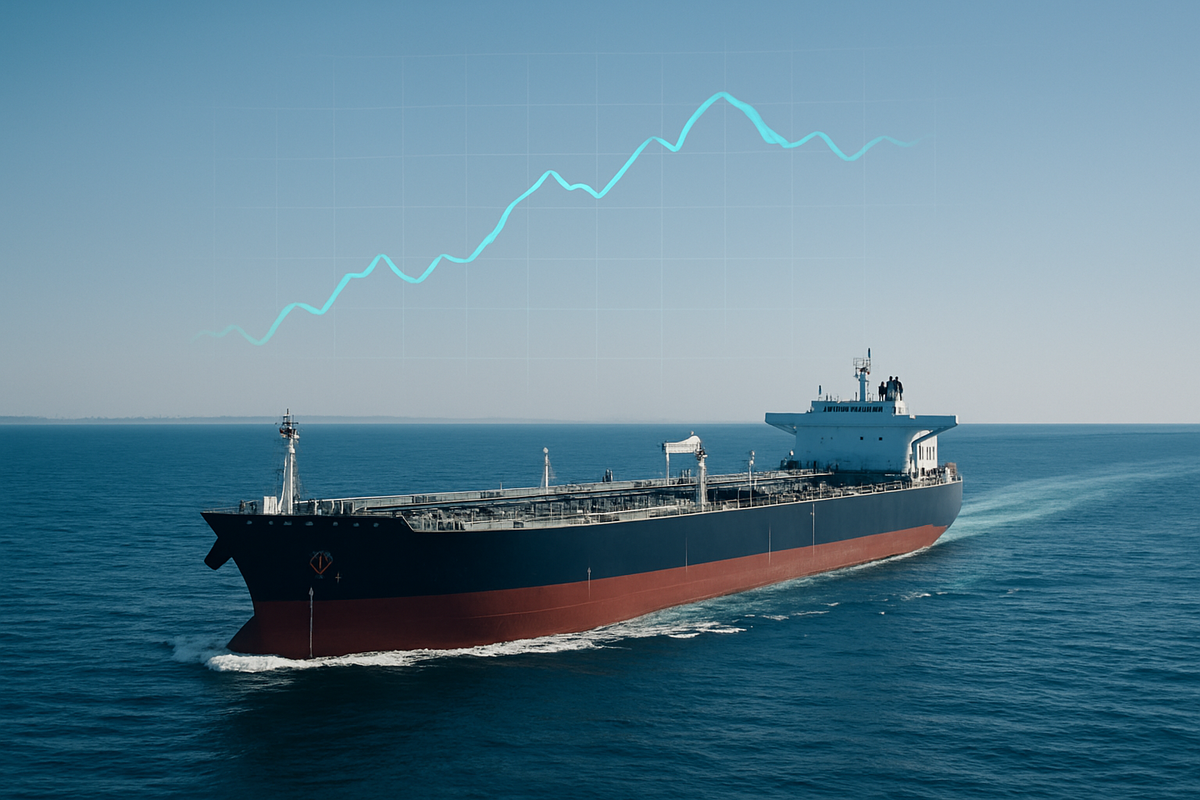VLCC Tanker Rates Ease from October Peaks, But Firmness Persists Amid Robust Demand
By:
MarketMinute
November 06, 2025 at 11:38 AM EST

London, UK – November 6, 2025 – The global Very Large Crude Carrier (VLCC) market is navigating a complex landscape, as tanker rates, while easing slightly from the multi-year highs observed in late October, continue to demonstrate remarkable firmness. This sustained strength, with daily earnings consistently projected above $100,000, signals a robust and enduring upcycle for the shipping sector, driven by an intricate web of strong demand, constrained vessel supply, and evolving geopolitical dynamics. The slight correction from October's dizzying peaks, which saw some benchmark routes surpass $125,000 per day and individual fixtures reach over $150,000 per day, is largely attributed to profit-taking and minor market adjustments. However, industry analysts and market participants anticipate that any downside will be capped, ensuring rates remain well into triple digits. This resilience underscores a fundamental shift in market conditions, where underlying demand for crude oil transportation services remains exceptionally strong, setting the stage for a potentially protracted period of elevated freight costs. Unpacking the Market's Recent DynamicsOctober 2025 marked an extraordinary period for the VLCC market, with rates surging to levels not seen in half a decade. The Baltic Exchange's global average VLCC time-charter equivalent (TCE) index soared to $108,833 per day by October 30, a figure last witnessed in April 2020. The benchmark Middle East Gulf (MEG) to China route (TD3C) was particularly volatile, with spot rates increasing by an astonishing 42% in a single day, settling at $125,081 per day by month-end. Specific fixtures on this route were even more lucrative, with one reported at an eye-watering $153,846 per day on October 29. These unprecedented highs were a culmination of mounting demand pressures and tightening supply that had been building throughout the year, with the MEG-to-China route already hitting the $100,000 per day threshold in September. The lead-up to this market fervor can be traced back to several converging factors throughout 2025. A significant surge in global oil demand, particularly with the onset of the winter season, has been a primary catalyst. Concurrently, OPEC+ has maintained a strategy of increasing oil production since the latter half of the year, injecting more crude into the global supply chain that requires transportation. China, the world's largest crude oil importer, has played a pivotal role, actively purchasing oil for its strategic reserves and bolstering commercial inventories ahead of a new Energy Law taking effect in January 2025. Key players in this environment include major VLCC operators such as Euronav (EBR: EURN), Frontline (NYSE: FRO), DHT Holdings (NYSE: DHT), and International Seaways (NYSE: INSW), all of whom have been direct beneficiaries of the rate surge. Oil majors and national oil companies (NOCs) are the primary charterers, facing increased transportation costs. Initial market reactions saw a rush to secure available tonnage, leading to minimal vessel availability in certain loading windows and driving rates skyward. The Israel-Iran conflict in June 2025 further exacerbated the situation by disrupting traditional trade routes, leading to longer-haul voyages and significantly increasing tonne-mile demand, as exemplified by increased Indian crude imports from the US via VLCCs. This geopolitical instability, coupled with ongoing sanctions on Russian energy exports, has fundamentally reshaped global crude flow patterns. Companies Navigating the High SeasThe current robust VLCC tanker rates present a clear boon for publicly traded shipping companies specializing in crude oil transportation, while potentially increasing costs for oil producers and refiners. Potential Winners:
These companies will likely see improved financial metrics, including higher revenues, increased net income, and stronger cash flows. This could also lead to an appreciation in their stock prices, reflecting the positive market sentiment and improved earnings outlook. The elevated rates also enhance the value of their existing assets, potentially making them more attractive for mergers and acquisitions or enabling them to secure more favorable financing terms for newbuilds. Potential Losers (or those facing increased costs):
The impact on these entities is primarily one of increased operational expenditure. While major oil companies have integrated shipping operations, they still rely heavily on the spot market for additional tonnage, making them susceptible to rate fluctuations. Wider Significance and Market ImplicationsThe sustained firmness in VLCC tanker rates, even after easing from their October peaks, is indicative of several profound shifts within the global energy and shipping landscapes. This event is not an isolated incident but rather fits into broader industry trends characterized by increasing geopolitical influence on trade routes, a tightening supply of new vessels, and evolving environmental regulations. Firstly, the increased use of longer-haul routes, driven by geopolitical events such as the Israel-Iran conflict in June 2025 and ongoing sanctions on Russian energy, has fundamentally altered tonne-mile demand. This 're-routing' of global crude flows means that even with stable crude volumes, more ships are needed for longer periods, effectively reducing available capacity. This trend is likely to persist as geopolitical tensions remain a significant factor in global trade. Secondly, the global VLCC fleet is aging, and newbuild deliveries are scarce. With only 34 new VLCCs scheduled for delivery in 2026, the effective capacity growth is expected to stagnate. This tight vessel supply is exacerbated by low demolition activity, as high freight rates make even older, less efficient tankers economically viable. However, this dynamic is temporary; tightening environmental regulations (e.g., IMO 2020 and future decarbonization targets) are anticipated to accelerate demolition post-2026, creating a future supply crunch for modern, eco-friendly vessels. The ripple effects extend to global oil prices and supply chain stability. Higher shipping costs ultimately feed into the landed cost of crude oil, potentially contributing to inflationary pressures on energy prices for consumers worldwide. Port congestion, particularly in China, and new port fees introduced by China on US-linked vessels have created operational inefficiencies, slowing down vessel turnaround times and further tightening regional tonnage availability. This has led to a two-tier market, introducing significant surcharges and increasing overall operational costs. Historically, periods of sustained high tanker rates have often coincided with geopolitical disruptions or significant demand surges. The current environment draws parallels to the early 2000s commodity supercycle or specific periods of heightened Middle East tensions. However, the added layer of stringent environmental regulations and a constricted newbuild order book presents a unique challenge and opportunity compared to previous cycles, suggesting a more structural shift rather than a purely cyclical one. What Comes Next: Navigating the Future of Oil TransportLooking ahead, the VLCC market is poised for continued strength in the short to medium term, although volatility remains a constant. The immediate future, particularly through the upcoming winter, is expected to see sustained high earnings for tanker operators. The estimated 50+ cargoes requiring coverage in the late November window alone underscore the persistent demand. Short-term possibilities:
Long-term possibilities:
Strategic pivots and adaptations will be crucial for all stakeholders. Tanker operators will need to carefully manage their fleet, consider newbuild orders with future-proof technologies, and optimize routing to mitigate port congestion and geopolitical risks. Oil companies will need to factor in higher and potentially more volatile shipping costs into their supply chain planning and potentially explore longer-term freight contracts to secure capacity. Market opportunities may emerge in specialized segments, such as eco-friendly tankers or vessels equipped for specific trade routes. Potential scenarios range from a sustained "super-cycle" driven by persistent demand and supply constraints to periods of increased volatility due to unforeseen global events. Investors should closely monitor oil demand forecasts, newbuild order books, geopolitical developments, and regulatory changes. Comprehensive Wrap-Up: A Resilient Market in FluxThe current state of VLCC tanker rates reflects a market in dynamic equilibrium, where an easing from October's multi-year highs is balanced by an unwavering underlying firmness. The key takeaway is that the factors driving this strength – robust winter demand, strategic stockpiling by major importers like China, increased OPEC+ production, and critically, a tight global vessel supply exacerbated by geopolitical rerouting and port inefficiencies – are structural rather than transient. Moving forward, the market is poised to remain strong, offering significant opportunities for well-positioned tanker operators. While the immediate peaks may have receded, the sustained triple-digit daily earnings underscore a healthy and resilient sector. The confluence of an aging fleet, limited newbuild capacity, and the imperative for decarbonization will continue to shape the industry, making investments in modern, efficient vessels a strategic necessity. Investors should closely watch several indicators in the coming months: the pace of global oil demand growth, particularly from Asia; any shifts in OPEC+ production policies; the geopolitical landscape, especially in the Middle East and major shipping lanes; and the impact of new environmental regulations on fleet composition and operating costs. The VLCC market, while inherently cyclical, appears to be in a phase where fundamental supply-demand imbalances and external factors are creating a prolonged period of elevated profitability, making it a compelling area for those invested in global trade and energy logistics. This content is intended for informational purposes only and is not financial advice More NewsView More

Is American Express the Credit Stock For a K-Shaped Economy? ↗
Today 15:23 EST
Via MarketBeat

Powering Up: How a Credit Upgrade Fuels Vistra’s AI Ambitions ↗
Today 13:53 EST

Is CrowdStrike Ready to Rally After Its Recent Pullback? ↗
Today 11:33 EST
Via MarketBeat
Tickers
CRWD

SanDisk Joins the S&P 500: Inside the Index Effect Rally ↗
Today 10:45 EST
Recent QuotesView More
Stock Quote API & Stock News API supplied by www.cloudquote.io
Quotes delayed at least 20 minutes. By accessing this page, you agree to the Privacy Policy and Terms Of Service.
© 2025 FinancialContent. All rights reserved.
|